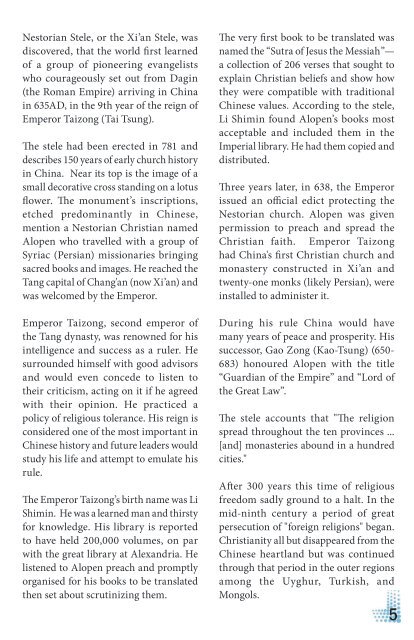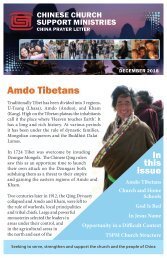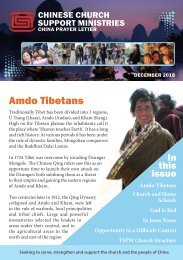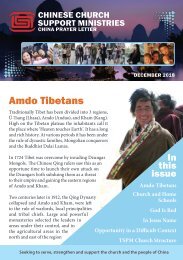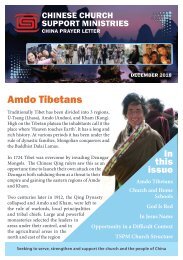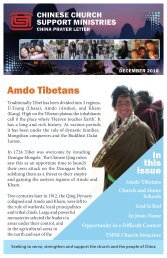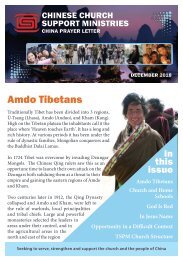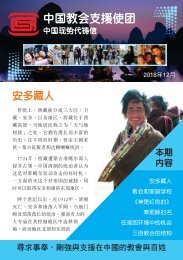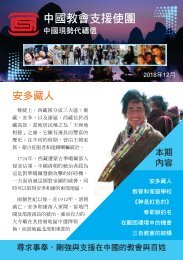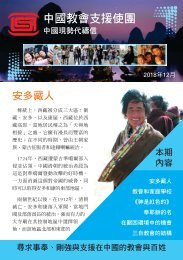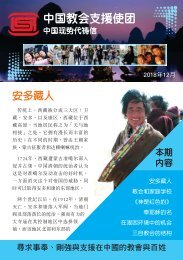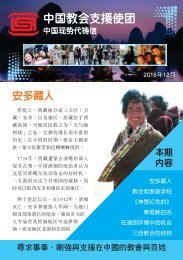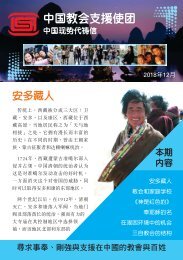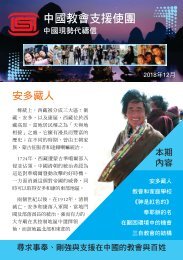Canada November 2018
Create successful ePaper yourself
Turn your PDF publications into a flip-book with our unique Google optimized e-Paper software.
Nestorian Stele, or the Xi’an Stele, was<br />
discovered, that the world first learned<br />
of a group of pioneering evangelists<br />
who courageously set out from Dagin<br />
(the Roman Empire) arriving in China<br />
in 635AD, in the 9th year of the reign of<br />
Emperor Taizong (Tai Tsung).<br />
The stele had been erected in 781 and<br />
describes 150 years of early church history<br />
in China. Near its top is the image of a<br />
small decorative cross standing on a lotus<br />
flower. The monument’s inscriptions,<br />
etched predominantly in Chinese,<br />
mention a Nestorian Christian named<br />
Alopen who travelled with a group of<br />
Syriac (Persian) missionaries bringing<br />
sacred books and images. He reached the<br />
Tang capital of Chang'an (now Xi’an) and<br />
was welcomed by the Emperor.<br />
Emperor Taizong, second emperor of<br />
the Tang dynasty, was renowned for his<br />
intelligence and success as a ruler. He<br />
surrounded himself with good advisors<br />
and would even concede to listen to<br />
their criticism, acting on it if he agreed<br />
with their opinion. He practiced a<br />
policy of religious tolerance. His reign is<br />
considered one of the most important in<br />
Chinese history and future leaders would<br />
study his life and attempt to emulate his<br />
rule.<br />
The Emperor Taizong’s birth name was Li<br />
Shimin. He was a learned man and thirsty<br />
for knowledge. His library is reported<br />
to have held 200,000 volumes, on par<br />
with the great library at Alexandria. He<br />
listened to Alopen preach and promptly<br />
organised for his books to be translated<br />
then set about scrutinizing them.<br />
The very first book to be translated was<br />
named the “Sutra of Jesus the Messiah”—<br />
a collection of 206 verses that sought to<br />
explain Christian beliefs and show how<br />
they were compatible with traditional<br />
Chinese values. According to the stele,<br />
Li Shimin found Alopen’s books most<br />
acceptable and included them in the<br />
Imperial library. He had them copied and<br />
distributed.<br />
Three years later, in 638, the Emperor<br />
issued an official edict protecting the<br />
Nestorian church. Alopen was given<br />
permission to preach and spread the<br />
Christian faith. Emperor Taizong<br />
had China's first Christian church and<br />
monastery constructed in Xi’an and<br />
twenty-one monks (likely Persian), were<br />
installed to administer it.<br />
During his rule China would have<br />
many years of peace and prosperity. His<br />
successor, Gao Zong (Kao-Tsung) (650-<br />
683) honoured Alopen with the title<br />
“Guardian of the Empire” and “Lord of<br />
the Great Law”.<br />
The stele accounts that "The religion<br />
spread throughout the ten provinces ...<br />
[and] monasteries abound in a hundred<br />
cities."<br />
After 300 years this time of religious<br />
freedom sadly ground to a halt. In the<br />
mid-ninth century a period of great<br />
persecution of "foreign religions" began.<br />
Christianity all but disappeared from the<br />
Chinese heartland but was continued<br />
through that period in the outer regions<br />
among the Uyghur, Turkish, and<br />
Mongols.<br />
5


